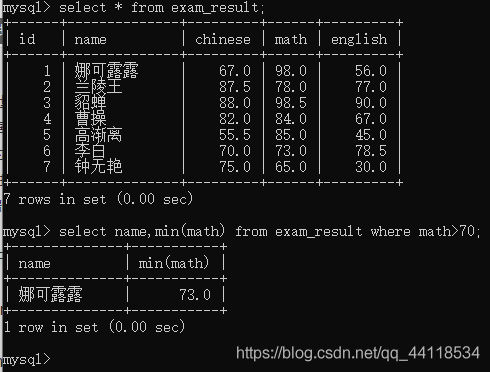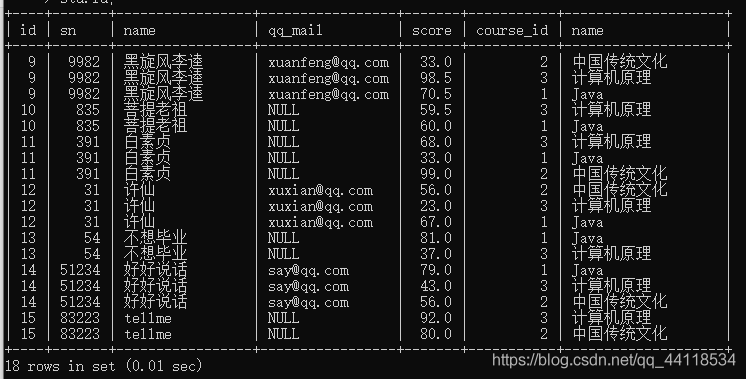MySQL表的增删改查(进阶)下
4.查询
4.1聚合查询
4.1.1聚合函数
在MySQL中常见的统计可以使用聚合函数来实现,常见的聚合函数有:
| 函数 | 说明 |
|---|---|
| count[dintinct] expr | 返回查询到的数量(行数) |
| sum[dintinct] expr | 返回查询到的数据的总和 |
| avg[dintinct] expr | 返回查询到的数据的平均值 |
| max[dintinct] expr | 返回查询到的数据的最大值 |
| min[dintinct] expr | 返回查询到的数据的最小值 |
案例:
在之前的exam_result表中返回 > 70 分以上的数学最低分。
SELECT MIN(math) FROM exam_result WHERE math > 70;
注意:
这里的最小值是指在math>70的前提下的最小值,意思是在执行聚合函数取最小值之前先进行where条件筛选,在筛选结果中取最小值。

4.1.2 group by 子句
在select 查询中使用group by子句可以对指定的列进行分组查询。
准备测试案例:
准备测试表及数据:职员表,有id(主键)、name(姓名)、role(角色)、salary(薪水)
create table emp(
id int primary key auto_increment,
name varchar(20) not null,
role varchar(20) not null,
salary numeric(11,2)
);
-- 插入数据
insert into emp(name, role, salary) values
('马云','服务员', 1000.20),
('马化腾','游戏陪玩', 2000.99),
('孙悟空','游戏角色', 999.11),
('猪无能','游戏角色', 333.5),
('沙和尚','游戏角色', 700.33),
('隔壁老王','董事长', 12000.66);
简单演示一下什么是分组,插入上面的数据之后执行下列语句:
查询每个角色的最高工资、最低工资和平均工资
select count(name),role,max(salary),min(salary),avg(salary) from emp group by role;

group by以role分为4组,在执行求和,平均值等一些聚合函数时是在求每个组里面的总和,平均值等。
注意:
如上面的查询语句,select指定的字段(要显示的列)必须是group by后面的分组依据字段(这里是role)若想要显示其他字段则必须包含在聚合函数中。
4.1.3 having语句
GROUP BY 子句进行分组以后,需要对分组结果再进行条件过滤时,不能使用 WHERE 语句,而需要用HAVING。
即where语句是在分组之前进行条件过滤(数据筛选),而要想对分组之后的数据再次进行条件过滤则需要使用having语句。
例如:
显示平均工资低于1500的角色和它的平均工资。
select role,max(salary),min(salary),avg(salary) from emp group by role having avg(salary)<1500;
4.2.联合查询(重点)
实际开发中往往数据来自不同的表,所以需要多表联合查询。多表查询是对多张表的数据取笛卡尔积:

例如上图对 R表和S表取笛卡尔积得到表T,即对两张表进行排列组合得到的集合。
注意:
关联查询允许对表取别名。
测试数据准备:
insert into classes(name, `desc`) values
('计算机系2019级1班', 'C和Java语言、数据结构和算法'),
('中文系2019级3班','学习了中国传统文学'),
('自动化2019级5班','学习了机械自动化');
insert into student(sn, name, qq_mail, classes_id) values
(09982,'黑旋风李逵','[email protected]',1),
(00835,'菩提老祖',null,1),
(00391,'白素贞',null,1),
(00031,'许仙','[email protected]',1),
(00054,'不想毕业',null,1),
(51234,'好好说话','[email protected]',2),
(83223,'tellme',null,2),
(09527,'老外学中文','[email protected]',2);
insert into course(name) values
('Java'),('中国传统文化'),('计算机原理'),('语文'),('高阶数学'),('英文');
insert into score(score, student_id, course_id) values
-- 黑旋风李逵
(70.5, 9, 1),(98.5, 9, 3),(33, 9, 2),
-- 菩提老祖
(60, 10, 1),(59.5,10, 3),
-- 白素贞
(33, 11, 1),(68, 11, 3),(99, 11, 2),
-- 许仙
(67, 12, 1),(23, 12, 3),(56, 12, 2),
-- 不想毕业
(81, 13, 1),(37, 13, 3),
-- 好好说话
(56, 14, 2),(43, 14, 3),(79, 14, 1),
-- tellme
(80, 15, 2),(92, 15, 3);
4.2.1 内连接
语法:
select 字段 from 表1 别名1 [inner] join 表2 别名2 on 连接条件 and 其他条件;
select 字段 from 表1 别名1,表2 别名2 where 连接条件 and 其他条件;
案例:
查询“许仙”同学的 成绩
select
stu.name, -- 学生表中的name字段
sco.score -- 成绩表的成绩列
from
student stu -- 表1 学生表的别名stu
inner join score sco -- 表2成绩表 别名为sco
on stu.id=sco.student_id and stu.name='许仙';
连接条件:inner join成绩表中的id字段=成绩表中的student_id字段,and学生的名字为许仙

查询所有同学的成绩,及同学的个人信息:
学生表、成绩表、课程表3张表关联查询
select
-- 这里因为是不同的表中的字段所以表示字段时需要用表名.字段
stu.id,
stu.sn,
stu.name,
stu.qq_mail,
sco.score,
sco.course_id,
cou.name
from
student stu
join score sco on stu.id = sco.student_id
join course cou on sco.course_id = cou.id
order by
stu.id;
外连接又分为左连接和右连接。如果联合查询,左侧的表完全显示我们叫左连接,右侧的表完全显示我们叫右连接。
语法:
左外连接,表1完全显示
select 字段名 from 表名1 left join 表名2 on 连接条件;
右外连接,表2完全显示
select 字段 from 表名1 right join 表名2 on 连接条件;
案例:查询所有同学的成绩,及同学的个人信息,如果该同学没有成绩,也需要显示。
学生表、成绩表、课程表3张表关联查询
SELECT
stu.id,
stu.sn,
stu.NAME,
stu.qq_mail,
sco.score,
sco.course_id,
cou.NAME
FROM
student stu
LEFT JOIN score sco ON stu.id = sco.student_id
LEFT JOIN course cou ON sco.course_id = cou.id
ORDER BY
stu.id
4.2.3 自连接
自连接是指在同一张表连接自身 进行查询。
案例:
显示所有“计算机原理”成绩比“Java”成绩高的成绩信息
SELECT
stu.*,
s1.score Java,
s2.score 计算机原理
FROM
score s1
JOIN score s2 ON s1.student_id = s2.student_id
JOIN student stu ON s1.student_id = stu.id
JOIN course c1 ON s1.course_id = c1.id
JOIN course c2 ON s2.course_id = c2.id
AND s1.score < s2.score
AND c1.NAME = 'Java'
AND c2.NAME = '计算机原理';
4.2.4 子查询
子查询是指嵌入在其他sql语句中的select语句,也叫嵌套查询。
案例:
查询与“不想毕业” 同学的同班同学:
select * from student where classes_id=(select classes_id from student where name=‘不想毕业’);

4.2.5 合并查询
在实际应用中,为了合并多个select的执行结果,可以使用集合操作符 union,union all。使用UNION和UNION ALL时,前后查询的结果集中,字段需要一致。
- union
该操作符用于取得两个结果集的并集。当使用该操作符时,会自动去掉结果集中的重复行。
案例:
查询id小于3,或者名字为“英文”的课程:
select * from course where id<3
union
select * from course where name='英文';
- union all
该操作符用于取得两个结果集的并集。当使用该操作符时,不会去掉结果集中的重复行。
案例:
查询id小于3,或者名字为“Java”的课程。
select * from course where id<3
union all
select * from course where name='英文';

